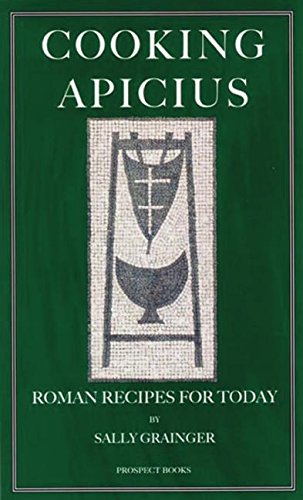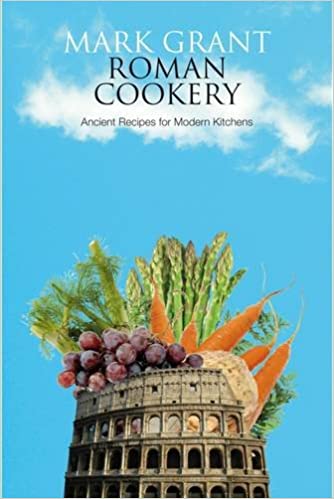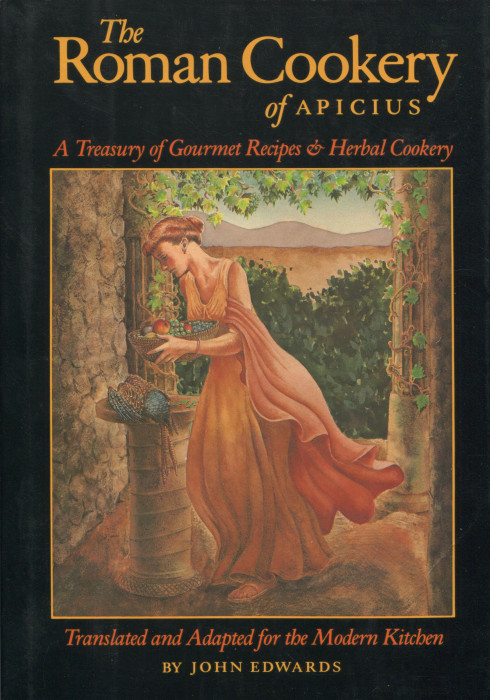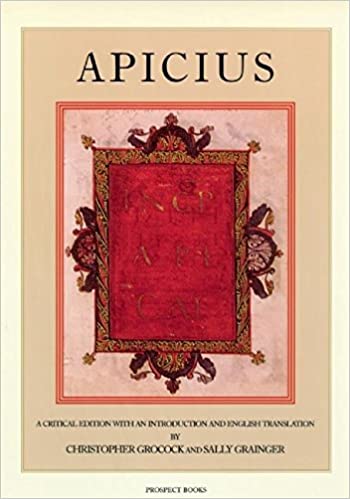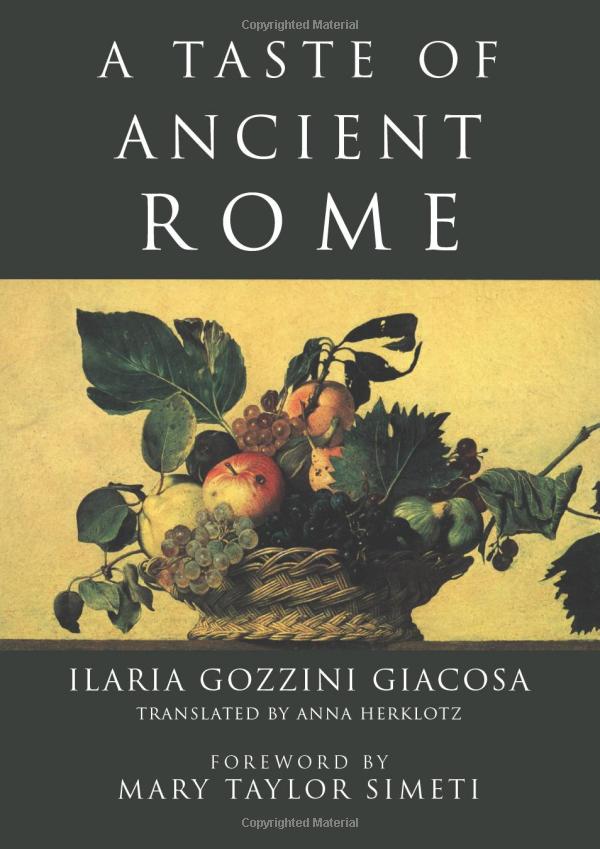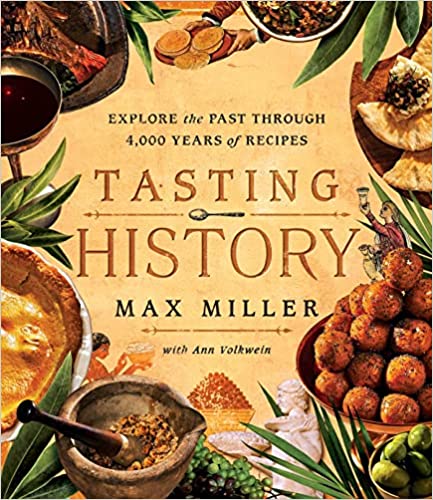

Bookstore Main Categories
Roman food... the tastes and smells of centuries past — exotic and strange, yet... something that is strangely familiar, a part of our racial memory. The food that our Roman forebears ate was different in a number of ways: taste, smell and even texture. Roman food, and the recipes that make it, isn't bad, it's just different and that, is what we hope to impart in this section.
Author: Sally Grainger
Prospect Books
Why is this first? Well, for one, Sally is one of the cooler and more knowledgeable people on the subject of modern cooking AND, she nicely let me use part of her book on the Romans in Britain website about Garum. Buy her book, watch her videos on YouTube wherein she has a channel called A taste of the ancient world
Sally Grainger has gathered, in one convenient volume, her modern interpretations of 64 of the recipes in the original text. This is not ‘recipes inspired by the old Romans’ but rather a serious effort to convert the extremely gnomic instructions in the Latin into something that can be reproduced in the modern kitchen which actually gives some idea of what the Romans might have eaten. Sally Grainger, therefore, has taken great pains to suggest means of replicating the particular Roman taste for fermented fish sauce. It may sound unpleasant, but actually is not too far removed from the fish sauces of the Far East and any reproduction of Roman cookery must depend on getting this particular aspect right.
Sally Grainger has gathered, in one convenient volume, her modern interpretations of 64 of the recipes in the original text. This is not ‘recipes inspired by the old Romans’ but rather a serious effort to convert the extremely gnomic instructions in the Latin into something that can be reproduced in the modern kitchen which actually gives some idea of what the Romans might have eaten. Sally Grainger, therefore, has taken great pains to suggest means of replicating the particular Roman taste for fermented fish sauce. It may sound unpleasant, but actually is not too far removed from the fish sauces of the Far East and any reproduction of Roman cookery must depend on getting this particular aspect right.
Author: Mark Grant
Interlink Publishing
Roman Cookery unveils one of Europe's last great culinary secrets — the food eaten by the ordinary people of ancient Rome. Based on olive oil, fish, herbs and vegetables, it was the origin of modern European cooking and, in particular, of what we now call the "Mediterranean diet".
Mark Grant, author and reasearcher extraordinaire, has unearthed everyday recipes like tuna wrapped in vine leaves, olive oil bread flavoured with cheese, and honeyed quinces. Like an archaeologist uncovering a kitchen at Pompeii, he reveals treasures such as ham in red wine and fennel sauce, honey and sesame pizza, and walnut and fig cakes. The Romans were great lovers of herbs and Roman Cookery offers a range of herb sauces and purees, originally made with a pestle and mortar but here adapted, like all the dishes in this award-winning book, to be made with modern kitchen equipment. This revised and expanded edition includes previously unknown recipes, allowing the reader to savour more than a hundred simple but refined dishes that were first enjoyed more than two millennia ago.
As Amazon.com says: Here is a complete range of traditional Roman dishes, such as olive oil bread flavored with cheese. Included are explanations of the cultural values Romans ascribed to food and the social context in which it was prepared and eaten. While most Roman cookbooks detail complex banquet food enjoyed by only a tiny social elite, this cookbook provides easily made recipes for breakfast, lunch and dinner that can be enjoyed by everyone.
The recipes are easy to follow, and the ones I've tried so far are not very fussy, and the results quite tasty. I really like that this focuses on "everyday" foods, and that it includes the (translated) original reference, so you can adjust or re-interpret for yourself. One thing about Roman food is that there are ingriedients that we aren;'t used to — Roma food isn't bad, it often has a different taste. Sometimes that might bring back a racial memory that you didn't know existed.
The ingredients are often given in weights, so if you plan to make any of these recipes it's a good idea to have a kitchen scale on hand. Also, fair warning, apparently the Romans ate an unbelievable amount of cheese. Which I guess makes sense, since most people wouldn't have been able to afford meat or fish that often. Dates Alexandrine are great.
Mark Grant, author and reasearcher extraordinaire, has unearthed everyday recipes like tuna wrapped in vine leaves, olive oil bread flavoured with cheese, and honeyed quinces. Like an archaeologist uncovering a kitchen at Pompeii, he reveals treasures such as ham in red wine and fennel sauce, honey and sesame pizza, and walnut and fig cakes. The Romans were great lovers of herbs and Roman Cookery offers a range of herb sauces and purees, originally made with a pestle and mortar but here adapted, like all the dishes in this award-winning book, to be made with modern kitchen equipment. This revised and expanded edition includes previously unknown recipes, allowing the reader to savour more than a hundred simple but refined dishes that were first enjoyed more than two millennia ago.
As Amazon.com says: Here is a complete range of traditional Roman dishes, such as olive oil bread flavored with cheese. Included are explanations of the cultural values Romans ascribed to food and the social context in which it was prepared and eaten. While most Roman cookbooks detail complex banquet food enjoyed by only a tiny social elite, this cookbook provides easily made recipes for breakfast, lunch and dinner that can be enjoyed by everyone.
The recipes are easy to follow, and the ones I've tried so far are not very fussy, and the results quite tasty. I really like that this focuses on "everyday" foods, and that it includes the (translated) original reference, so you can adjust or re-interpret for yourself. One thing about Roman food is that there are ingriedients that we aren;'t used to — Roma food isn't bad, it often has a different taste. Sometimes that might bring back a racial memory that you didn't know existed.
The ingredients are often given in weights, so if you plan to make any of these recipes it's a good idea to have a kitchen scale on hand. Also, fair warning, apparently the Romans ate an unbelievable amount of cheese. Which I guess makes sense, since most people wouldn't have been able to afford meat or fish that often. Dates Alexandrine are great.
Author: John Edwards
Rodale Pr
This is the first book I was aware of that had ACTUAL Roman recipes. Someone I used to be friends with, turned me on to it. And the thing is, it's a great book. Dates Alexandrine is so good. Anyway, this is really the beginning for many people who are into Roman cooking.
Apicius , first century author of De Re Conquinaria (On Cookery), has been described as the most demanding of gourmets, and his amazingly sophisticated recipes havve long been awaiting rediscovery with practical adaptation for the modern kitchen. In The Roman Cookery of Apicius, John Edwards has given us a new, close translation of Apicius' manual, coupled with his adpted and tested versions of 360 superb recipes. Most attractive for modern lovers of fine cookery is the enormous variety, orginality and richness of flavours, achieved with entirely pure and natural ingredients. The many kinds of meats, vegetables, fish, fowl, shellfish, cheeses, fruits, nuts, herbs, spices, honey and wines — all familiar in themselves — here appear delectably transformed in surprising combinations. One can prepare theses recipes and actually experience the distinctive dishes of Apicius' day, with flavours that range from the delicate and subtle to the hot and pungent, or the richly sweet. This is a perfect manual for food lovers an adventurous cooks, hoping to be inspired.
If you want to be on a gluten free diet and have an adventure at the same time, this is a fun book. Fun for both teachers of nutrition and their students to hear about ingredients they have heard of, but no one ever uses now — something new to help. The ancient ways were often healthier.
Apicius , first century author of De Re Conquinaria (On Cookery), has been described as the most demanding of gourmets, and his amazingly sophisticated recipes havve long been awaiting rediscovery with practical adaptation for the modern kitchen. In The Roman Cookery of Apicius, John Edwards has given us a new, close translation of Apicius' manual, coupled with his adpted and tested versions of 360 superb recipes. Most attractive for modern lovers of fine cookery is the enormous variety, orginality and richness of flavours, achieved with entirely pure and natural ingredients. The many kinds of meats, vegetables, fish, fowl, shellfish, cheeses, fruits, nuts, herbs, spices, honey and wines — all familiar in themselves — here appear delectably transformed in surprising combinations. One can prepare theses recipes and actually experience the distinctive dishes of Apicius' day, with flavours that range from the delicate and subtle to the hot and pungent, or the richly sweet. This is a perfect manual for food lovers an adventurous cooks, hoping to be inspired.
If you want to be on a gluten free diet and have an adventure at the same time, this is a fun book. Fun for both teachers of nutrition and their students to hear about ingredients they have heard of, but no one ever uses now — something new to help. The ancient ways were often healthier.
Author: Marcus Gavius Apicius (Author), Sally Grainger (Editor), Christopher Grocock (Translator)
Prospect Books
Apicius is the sole remaining cookery book from the days of the Roman Empire. Though there were many ancient Greek and Latin works concerning food, this collection of recipes is unique. The editors suggest that it is a survival from many such collections maintained by working cooks and that the attribution to Apicius the man (a real-life Roman noble of the 2nd century AD), is a mere literary convention. There have been many English translations of this work (and, abroad, some important academic editions) but none reliable since 1958 (Flower and Rosenbaum). In any case, this edition and translation has revisited all surviving manuscripts in Europe and the USA and proposes many new readings and interpretations. The great quality of this editorial team is while the Latin scholarship is supplied by Chris Grocock, Sally Grainger contributes a lifetime’s experience in the practical cookery of adaptations of the recipes in this text. This supplies a wholly new angle from which to verify the textual and editorial suggestions.
Author: Ilaria Gozzini Giacosa (Author), Anna Herklotz (Translator)
University of Chicago Press
From appetizers to desserts, the rustic to the refined, here are more than two hundred recipes from ancient Rome tested and updated for today's tastes. With its intriguing sweet-sour flavor combinations, its lavish use of fresh herbs and fragrant spices, and its base in whole grains and fruits and vegetables, the cuisine of Rome will be a revelation to serious cooks ready to create new dishes in the spirit of an ancient culture.
Author: Max Miller
S&S/Simon Element
Why is this here? Because his YouTube chanel opens things up to people in a way that others might not. If you like historical foods, this is a great book for you. Watch his vids too.
What began as a passion project, when Max Miller was furloughed during Covid-19, has become a viral YouTube sensation. The Tasting History with Max Miller channel has thrilled food enthusiasts and history buffs alike, as Miller recreates a dish from the past, often using historical recipes from vintage texts, but updated for modern kitchens as he tells stories behind the cuisine and culture. From ancient Rome to Ming China to medieval Europe and beyond, Miller has collected the best-loved recipes from around the world and has shared them with his fans. Now, with beautiful photographs portraying the dishes and historical artwork throughout, Tasting History compiles over sixty dishes such as:
What began as a passion project, when Max Miller was furloughed during Covid-19, has become a viral YouTube sensation. The Tasting History with Max Miller channel has thrilled food enthusiasts and history buffs alike, as Miller recreates a dish from the past, often using historical recipes from vintage texts, but updated for modern kitchens as he tells stories behind the cuisine and culture. From ancient Rome to Ming China to medieval Europe and beyond, Miller has collected the best-loved recipes from around the world and has shared them with his fans. Now, with beautiful photographs portraying the dishes and historical artwork throughout, Tasting History compiles over sixty dishes such as:
- Tuh’u: a red beet stew with leeks dating back to 1740 BC
- Globi: deep-fried cheese balls with honey and poppy seeds
- Soul Cakes: yeasted buns with currants from circa 1600
- Pumpkin Tourte: a crustless pumpkin cheesecake with cinnamon and sugar on top from 1570
- And much more.
1352
Etienne Aubert elected as Pope Innocentius VI
Etienne Aubert elected as Pope Innocentius VI
1603
Admiral Steven van der Haghens fleet departs to East-Indies
Admiral Steven van der Haghens fleet departs to East-Indies
1621
English parliament accept unanimously, Protestation
English parliament accept unanimously, Protestation
1774
Empress Maria Theresa expels Jews from Prague, Bohemia and Moravia
Empress Maria Theresa expels Jews from Prague, Bohemia and Moravia
1783
English King George III fires government of Portland
English King George III fires government of Portland
1787
New Jersey becomes 3rd state to ratify constitution
New Jersey becomes 3rd state to ratify constitution
1796
1st US newspaper to appear on Sunday (Baltimore Monitor)
1st US newspaper to appear on Sunday (Baltimore Monitor)
1813
British take Ft Niagara in War of 1812
British take Ft Niagara in War of 1812
1832
Charles Darwins visits Vurland
Charles Darwins visits Vurland
1839
1st celestial photograph (of Moon) made in US, John Draper, New York City
1st celestial photograph (of Moon) made in US, John Draper, New York City
1849
William Bond obtains 1st photograph of Moon through a telescope
William Bond obtains 1st photograph of Moon through a telescope
1858
Passy, at Paris: 1st "Samedi soir" i / d villa of lovers Rossini
Passy, at Paris: 1st "Samedi soir" i / d villa of lovers Rossini
1859
South Carolina declared an "independent commonwealth"
South Carolina declared an "independent commonwealth"
1865
13th Amendment ratified, slavery abolished
13th Amendment ratified, slavery abolished
1865
1st US cattle importation law passed
1st US cattle importation law passed
1878
French SS Byzantin sinks after collision in Dardanellen, 210 killed
French SS Byzantin sinks after collision in Dardanellen, 210 killed
1890
Lugards expedition to Mengo / Kampala, Uganda
Lugards expedition to Mengo / Kampala, Uganda
1898
Automobile speed record set-63 km/h (39 mph)
Automobile speed record set-63 km/h (39 mph)
1899
Field Marshal Lord Roberts appointed British Supreme Commander in South Africa
Field Marshal Lord Roberts appointed British Supreme Commander in South Africa
1905
H V Hordern takes 8-81 in 2nd innings of F-C debut (New South Wales vs. Queensland)
H V Hordern takes 8-81 in 2nd innings of F-C debut (New South Wales vs. Queensland)
1915
President Wilson, widowed the year before, marries Edith Bolling Galt
President Wilson, widowed the year before, marries Edith Bolling Galt
1917
Soviet regiment (Stalin / Lenin) declares Finland Independent
Soviet regiment (Stalin / Lenin) declares Finland Independent
1920
1st US postage stamps printed without the words United States or US
1st US postage stamps printed without the words United States or US
1923
International zone of Tangier set up in Morocco
International zone of Tangier set up in Morocco
1930
Bradman scores 258 NSW vs. South Australia, 289 mins, 37 fours
Bradman scores 258 NSW vs. South Australia, 289 mins, 37 fours
1932
Chicago Bears beat Portsmouth Spartans 9-0 in 1st NFL playoff game
Chicago Bears beat Portsmouth Spartans 9-0 in 1st NFL playoff game
1935
Edward Benes becomes President of Czechoslovakia
Edward Benes becomes President of Czechoslovakia
1936
1st giant panda imported into US
1st giant panda imported into US
1936
Su-Lin, 1st giant panda to come to US from China, arrives in San Francisco
Su-Lin, 1st giant panda to come to US from China, arrives in San Francisco
1941
German submarine U-434 sinks
German submarine U-434 sinks
1941
Japanse troops land on Hong Kong
Japanse troops land on Hong Kong
1944
Destroyers "Hull, " "Spence" and"Monaghan" sink in typhoon (Philippines)
Destroyers "Hull, " "Spence" and"Monaghan" sink in typhoon (Philippines)
1944
Nazi occupiers of Amsterdam destroy electricity plants
Nazi occupiers of Amsterdam destroy electricity plants
1945
Uruguay joins UN
Uruguay joins UN
1947
Pope Pius XII publishes encyclical Optissima Pax
Pope Pius XII publishes encyclical Optissima Pax
1948
WDSU TV channel 6 in New Orleans, LA (NBC) begins broadcasting
WDSU TV channel 6 in New Orleans, LA (NBC) begins broadcasting
1949
Philadelphia Eagles beat LA Rams 14-0 in NFL championship game
Philadelphia Eagles beat LA Rams 14-0 in NFL championship game
1952
Ellis W Ryan resigns as Cleveland Indians President
Ellis W Ryan resigns as Cleveland Indians President
1953
KATV TV channel 7 in Little Rock, AR (ABC) begins broadcasting
KATV TV channel 7 in Little Rock, AR (ABC) begins broadcasting
1953
KMID TV channel 2 in Midland and Odessa, TX (ABC) begins broadcasting
KMID TV channel 2 in Midland and Odessa, TX (ABC) begins broadcasting
1956
Japan admitted to UN
Japan admitted to UN
1956
Phil Rizzuto signs as New York Yankee radio-TV announcer
Phil Rizzuto signs as New York Yankee radio-TV announcer
1956
"To Tell the Truth" debuts on CBS-TV
"To Tell the Truth" debuts on CBS-TV
1956
Israeli flag hoisted on Mount Sinai
Israeli flag hoisted on Mount Sinai
1957
Shippingport Atomic Power Stn, 1st nuke plant to generate electricity
Shippingport Atomic Power Stn, 1st nuke plant to generate electricity
1958
1st test project of Signal Communications by Orbiting Relay Equip
1st test project of Signal Communications by Orbiting Relay Equip
1958
1st voice from space: recorded Christmas message by Eisenhower
1st voice from space: recorded Christmas message by Eisenhower
1958
Niger gains autonomy within French Community (National Day)
Niger gains autonomy within French Community (National Day)
1959
Sammy Baugh named 1st coach of New York Titans (AFL)
Sammy Baugh named 1st coach of New York Titans (AFL)
1960
General Meeting of the UN condemns apartheid
General Meeting of the UN condemns apartheid
1961
For 2nd cons year, AP names Wilma Rudolph female athlete of year
For 2nd cons year, AP names Wilma Rudolph female athlete of year
1961
India annexes Portuguese colonies of Goa, Damao and Diu
India annexes Portuguese colonies of Goa, Damao and Diu
1961
KAIL TV channel 53 in Fresno, CA (IND) begins broadcasting
KAIL TV channel 53 in Fresno, CA (IND) begins broadcasting
1961
Wilt Chamberlain of NBA Philadelphia Warriors scores 78 points vs. LA
Wilt Chamberlain of NBA Philadelphia Warriors scores 78 points vs. LA
1962
WAIQ TV channel 26 in Montgomery, AL (PBS) begins broadcasting
WAIQ TV channel 26 in Montgomery, AL (PBS) begins broadcasting
1963
Clarke runs world record 10k (28:15.6)
Clarke runs world record 10k (28:15.6)
1964
"I Had a BaIl" opens at Martin Beck Theater NYC for 199 performances
"I Had a BaIl" opens at Martin Beck Theater NYC for 199 performances
1964
"The Pink Panther" cartoon series premieres (Pink Phink)
"The Pink Panther" cartoon series premieres (Pink Phink)
1964
During services held for Sam Cooke fans caused damage to Funeral Home
During services held for Sam Cooke fans caused damage to Funeral Home
1965
"La Grusse Valise" closes at 54th St. Theater NYC after 7 performances
"La Grusse Valise" closes at 54th St. Theater NYC after 7 performances
1965
Borman and Lovell Splash down in Atlantic ends 2 week Gemini VII mission
Borman and Lovell Splash down in Atlantic ends 2 week Gemini VII mission
1965
Kenneth LeBel jumps 17 barrels on ice skates
Kenneth LeBel jumps 17 barrels on ice skates
1969
"Coco" opens at Mark Hellinger Theater NYC for 333 performances
"Coco" opens at Mark Hellinger Theater NYC for 333 performances
1970
"Me Nobody Knows" opens at Helen Hayes Theater NYC for 587 performances
"Me Nobody Knows" opens at Helen Hayes Theater NYC for 587 performances
1970
Polish uprising fails
Polish uprising fails
1971
1st Candlelight Processional
1st Candlelight Processional
1971
CBS radio cancels Saturday morning band concerts
CBS radio cancels Saturday morning band concerts
1971
People United To Save Humanity (PUSH) forms by Jesse Jackson in Chic
People United To Save Humanity (PUSH) forms by Jesse Jackson in Chic
1972
US begins its heaviest bombing of North Vietnam
US begins its heaviest bombing of North Vietnam
1973
Soyuz 13 launched into Earth orbit for 8 days
Soyuz 13 launched into Earth orbit for 8 days
1973
Yanks sign Dick Williams as manager, overturned later by AL President
Yanks sign Dick Williams as manager, overturned later by AL President
1974
San Francisco Visitors Center at City Hall opens
San Francisco Visitors Center at City Hall opens
1976
"A Star is Born, " with Barbra Striesand, premieres
"A Star is Born, " with Barbra Striesand, premieres
1976
"Wonder Woman" debuts on ABC
"Wonder Woman" debuts on ABC
1976
Soviet dissident Viktor Bukovskiexchanged for Chile CP-leader Corvalan
Soviet dissident Viktor Bukovskiexchanged for Chile CP-leader Corvalan
1977
Cleveland Cavaliers retire jersey # 42, Nate Thumond
Cleveland Cavaliers retire jersey # 42, Nate Thumond
1977
Dutch Antilles: Premier Boy Rozendal points independence off
Dutch Antilles: Premier Boy Rozendal points independence off
1979
Stanley Barrett 1st to exceed land sonic speed (739.666 mph)
Stanley Barrett 1st to exceed land sonic speed (739.666 mph)
1980
Dutch 2nd Chamber accepts Minister Van Agts abortion laws
Dutch 2nd Chamber accepts Minister Van Agts abortion laws
1980
Vietnam adopts constitution
Vietnam adopts constitution
1983
NBA San Diego Clippers ends 29 game road losing streak
NBA San Diego Clippers ends 29 game road losing streak
1984
73rd Davis Cup: Sweden beats USA in Gothenburg (4-1)
73rd Davis Cup: Sweden beats USA in Gothenburg (4-1)
1985
UN Security Council unanimously condemns "acts of hostage-taking"
UN Security Council unanimously condemns "acts of hostage-taking"
1986
Mr Gates, serves as acting Director of CIA
Mr Gates, serves as acting Director of CIA
1987
Ivan F Boesky sentenced to 3 years for insider trading
Ivan F Boesky sentenced to 3 years for insider trading
1988
5th meeting of Giants-Jets, Jets win and eliminate Giants from playoffs
5th meeting of Giants-Jets, Jets win and eliminate Giants from playoffs
1988
Seattle Seahawks win their 1st ever division title with 9-7 record
Seattle Seahawks win their 1st ever division title with 9-7 record
1989
"I Love Lucy" Christmas episode, shown for 1st time in over 30 years
"I Love Lucy" Christmas episode, shown for 1st time in over 30 years
1990
NL announces Buffalo, Denver, Miami, Orlando, Tampa-St Petersburg, and Washington DC as 6 finalist for 1993 expansion (Miami & Denver win)
NL announces Buffalo, Denver, Miami, Orlando, Tampa-St Petersburg, and Washington DC as 6 finalist for 1993 expansion (Miami & Denver win)
1990
NL releases short list of teams for 1993 NL expansion
NL releases short list of teams for 1993 NL expansion
1991
DeForest Kelly (Dr McCoy on Star Trek) gets a star in Hollywood
DeForest Kelly (Dr McCoy on Star Trek) gets a star in Hollywood
1991
General Motors announces closing of 21 plants
General Motors announces closing of 21 plants
1992
FCC vote 4-1 to allow Infinity to purchase Cook Inlet stations
FCC vote 4-1 to allow Infinity to purchase Cook Inlet stations
1993
Kevin Scott skates world record 1K (1:12.54)
Kevin Scott skates world record 1K (1:12.54)
1994
"Comedy Tonight" opens at Lunt-Fontanne Theater NYC for 8 performances
"Comedy Tonight" opens at Lunt-Fontanne Theater NYC for 8 performances
1994
Darryl Strawberry pleads not guilty on tax evasion charges
Darryl Strawberry pleads not guilty on tax evasion charges
1994
General Hospital stars Kristina Malandro and Jack Wagner wed
General Hospital stars Kristina Malandro and Jack Wagner wed
1994
Socialist Party (ex-communist) wins Bulgaria parliamentary election
Socialist Party (ex-communist) wins Bulgaria parliamentary election
1996
TV industry execs agree to adopt a ratings system
TV industry execs agree to adopt a ratings system
